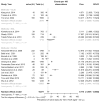Immunity to Varicella Zoster Virus in Healthcare Workers: A Systematic Review and Meta-Analysis (2024)
- PMID: 39340051
- PMCID: PMC11436139
- DOI: 10.3390/vaccines12091021
Immunity to Varicella Zoster Virus in Healthcare Workers: A Systematic Review and Meta-Analysis (2024)
Abstract
Healthcare workers (HCWs) are occupationally exposed to varicella zoster virus (VZV), and their inappropriate vaccination status could contribute to an outbreak involving both professionals and the patients they care for, with a potential impact on the general population. Therefore, since 2007, the Advisory Committee on Immunization Practices (ACIP) recommends that all HCWs have evidence of immunity against varicella. The present meta-analysis was therefore designed to collect the available evidence on the seronegative status of VZV among HCWs. PubMed, Scopus, and Embase databases were searched without backward limit for articles reporting on the seroprevalence of VZV among HCWs, and all articles meeting the inclusion criteria were included in a random-effect meta-analysis model. From 1744 initial entries, a total of 58 articles were included in the quantitative analysis (publication range: 1988 to 2024), for a pooled sample of 71,720 HCWs. Moreover, the included studies reported on seroprevalence data on measles (N = 36,043 HCWs) and rubella (N = 22,086 HCWs). Eventually, the pooled seronegative status for VZV was estimated to be 5.72% (95% confidence interval [95% CI] 4.59 to 7.10) compared to 6.91% (95% CI 4.79 to 9.87) for measles and 7.21% (5.36 to 9.64) for rubella, with a greater risk among subjects younger than 30 years at the time of the survey (risk ratio [RR] 1.434, 95% CI 1.172 to 1.756). Interestingly, medical history of either VZV infection/vaccination had low diagnostic performances (sensitivity 76.00%; specificity 60.12%; PPV of 96.12% but PNV of 18.64%). In summary, the available data suggest that newly hired HCWs are increasingly affected by low immunization rates for VZV but also for measles and rubella, stressing the importance of systematically testing test newly hired workers for all components of the measles-pertussis-rubella-varicella vaccine.
Keywords: chickenpox; healthcare workers; shingles; varicella zoster; varicella zoster vaccine.
Conflict of interest statement
The authors declare no conflicts of interest.
Figures



























Similar articles
-
Nosocomial transmission of chickenpox and varicella zoster virus seroprevalence rate amongst healthcare workers in a teaching hospital in China.BMC Infect Dis. 2019 Jul 5;19(1):582. doi: 10.1186/s12879-019-4222-x. BMC Infect Dis. 2019. PMID: 31277589 Free PMC article.
-
Performance Characteristics of a Multiplex Flow Immunoassay for Detection of IgG-Class Antibodies to Measles, Mumps, Rubella, and Varicella-Zoster Viruses in Presumptively Immune Health Care Workers.J Clin Microbiol. 2020 Mar 25;58(4):e00136-20. doi: 10.1128/JCM.00136-20. Print 2020 Mar 25. J Clin Microbiol. 2020. PMID: 32024728 Free PMC article.
-
Seroprevalence of Varicella-Zoster Virus and Measles among Healthcare Workers in a Tertiary Medical Center in Korea.Vaccines (Basel). 2022 Nov 18;10(11):1956. doi: 10.3390/vaccines10111956. Vaccines (Basel). 2022. PMID: 36423051 Free PMC article.
-
Vaccines for preventing herpes zoster in older adults.Cochrane Database Syst Rev. 2019 Nov 7;2019(11):CD008858. doi: 10.1002/14651858.CD008858.pub4. Cochrane Database Syst Rev. 2019. Update in: Cochrane Database Syst Rev. 2023 Oct 2;10:CD008858. doi: 10.1002/14651858.CD008858.pub5. PMID: 31696946 Free PMC article. Updated.
-
Vaccines for measles, mumps, rubella, and varicella in children.Cochrane Database Syst Rev. 2020 Apr 20;4(4):CD004407. doi: 10.1002/14651858.CD004407.pub4. Cochrane Database Syst Rev. 2020. Update in: Cochrane Database Syst Rev. 2021 Nov 22;11:CD004407. doi: 10.1002/14651858.CD004407.pub5. PMID: 32309885 Free PMC article. Updated.
Cited by
-
Risk of Nipah Virus Seroprevalence in Healthcare Workers: A Systematic Review with Meta-Analysis.Viruses. 2025 Jan 9;17(1):81. doi: 10.3390/v17010081. Viruses. 2025. PMID: 39861870 Free PMC article.
-
Vaccination Coverage and Associated Factors of Hepatitis B, Measles-Mumps-Rubella, Varicella, and Tetanus-Diphtheria-Acellular Pertussis Among Primary Health Care Workers in Qatar: A Retrospective Study (2020-2024).Cureus. 2025 Jun 28;17(6):e86901. doi: 10.7759/cureus.86901. eCollection 2025 Jun. Cureus. 2025. PMID: 40583921 Free PMC article.
-
The global burden of varicella and herpes zoster in adults aged 65 years and older: a comprehensive analysis based on the global burden of disease 2021.Aging Clin Exp Res. 2025 Aug 4;37(1):240. doi: 10.1007/s40520-025-03142-0. Aging Clin Exp Res. 2025. PMID: 40760212 Free PMC article.
-
Seroprevalence of Varicella-Zoster Virus and the Need for Herpes Zoster Vaccination Among Adults in Saudi Arabia.Cureus. 2025 Mar 21;17(3):e80949. doi: 10.7759/cureus.80949. eCollection 2025 Mar. Cureus. 2025. PMID: 40255817 Free PMC article.
References
-
- Rahaus M., Schünemann S., Wolff M.H. General Aspects Morphological and Biological Characteristics of Varicella-Zoster Virus. In: Wolff M., Schünemann S., Schmidt A., editors. Pathogenesis, and Clinical Aspects. Contrib Microbiol. Volume 3. Karger; Basel, Switzerland: 1999. pp. 1–9. - PubMed
Publication types
LinkOut - more resources
Full Text Sources

